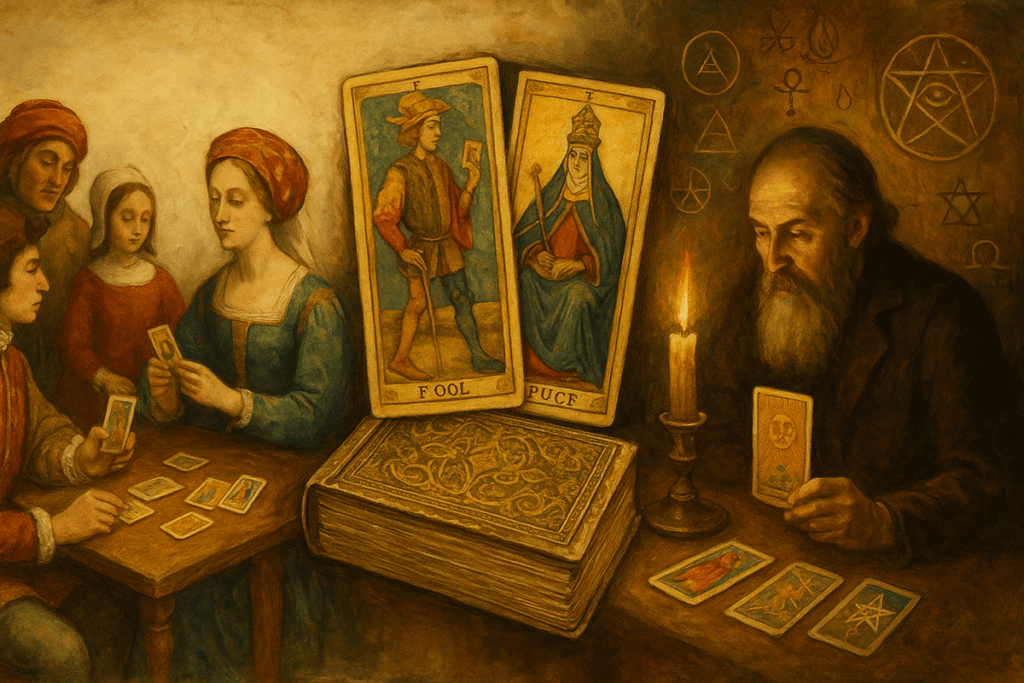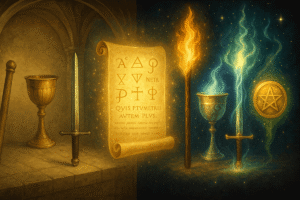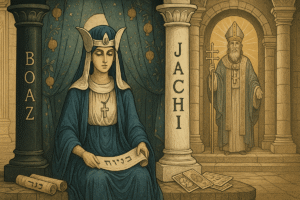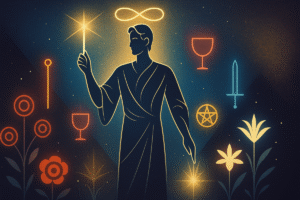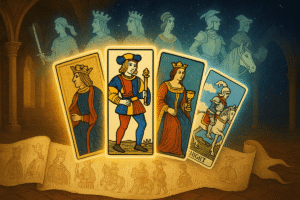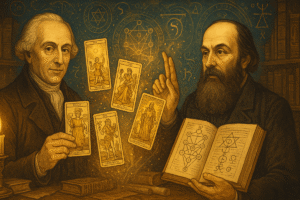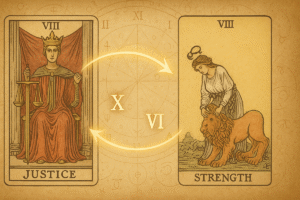Table of Contents
The shuffling of tarot cards carries whispers of centuries past. When I first held a deck, I wondered about all the hands that had touched similar cards before mine. Perhaps you’ve felt that same curiosity about these mysterious illustrated cards that have captivated people for over 600 years.
The journey from Renaissance gaming halls to modern meditation rooms tells a remarkable story of cultural transformation. Understanding this evolution might deepen your own relationship with tarot, whether you approach it as art, history, or personal reflection.
The Surprising Gaming Origins
Most people assume tarot began as a mystical practice, but the reality is more delightfully mundane. The earliest tarot decks emerged in 15th century Italy, specifically around the courts of Milan and Bologna, as elaborate card games for wealthy families.
These weren’t the 78-card decks we recognize today. The original “tarocchi” contained varying numbers of cards, sometimes as many as 97. Wealthy Italian families commissioned artists to create personalized decks featuring their own heraldry and local figures. The Visconti family’s deck from the 1440s remains one of the most famous examples, though several cards from the original set have been lost to time.
The game itself resembled modern bridge or spades. Players used the trump cards (what we now call the Major Arcana) to outrank the suit cards during trick-taking rounds. I find it fascinating that cards depicting Death, The Fool, and The World were originally just powerful game pieces, not mystical symbols.
The four suits varied by region. Northern Italian decks featured cups, coins, swords, and batons, while some areas preferred different imagery altogether. These regional variations remind us that tarot’s visual language developed organically across different communities rather than emerging from a single source.
Cultural Symbols in Medieval Context
The imagery adorning these early cards reflected the medieval worldview in ways that might surprise modern readers. The Major Arcana depicted a social hierarchy that medieval people would have immediately recognized. The Emperor and Empress represented earthly power, while The Pope (later renamed The Hierophant) embodied spiritual authority.
Perhaps most intriguingly, The Fool occupied a unique position. In medieval society, court jesters held special privileges to speak truth to power through humor and satire. This card’s placement outside the normal numerical sequence reflects that social reality. The Fool could interact with all levels of society precisely because he belonged to none.
The Wheel of Fortune resonated deeply with medieval consciousness. People of that era lived with constant reminders of life’s unpredictability through plagues, wars, and natural disasters. This card wasn’t abstract philosophy but lived experience.
The presence of Death in the deck might seem morbid to us, but medieval people had a different relationship with mortality. Death was a frequent visitor, not a distant concept. The card likely felt more matter-of-fact than frightening to its original audience.
Justice and Temperance reflected the cardinal virtues that structured medieval moral thinking. These weren’t just game symbols but representations of ideals that shaped daily life and social expectations.
The Mysterious Gap
Here’s where the story becomes genuinely puzzling. For roughly three centuries, from the late 1400s to the late 1700s, tarot remained primarily a card game. We have historical records of its popularity in various European courts, but virtually no documentation of its use for divination or spiritual purposes.
This gap raises fascinating questions. Did some people quietly use tarot for fortune-telling during these centuries without leaving written records? Were there underground traditions that historians simply haven’t uncovered? Or did the transformation to divination tool happen more suddenly than we realize?
I sometimes wonder what conversations might have taken place in 16th century Italian households. Did anyone look at The Star or The Moon cards and sense deeper meaning beyond their gaming function? The visual symbolism seems almost to invite contemplation, yet the historical record remains frustratingly silent.
The Protestant Reformation and Catholic Counter-Reformation created climates where mystical practices faced suspicion. This religious tension might explain the absence of documented esoteric uses during this period. Perhaps tarot’s mystical potential remained dormant until social conditions became more favorable.
The French Connection
The transformation began in earnest during the late 18th century French Enlightenment, though perhaps not in ways we might expect. French scholars and occultists “discovered” tarot through their fascination with ancient Egyptian wisdom.
Antoine Court de Gébelin, a Protestant pastor and Freemason, published a influential essay in 1781 claiming tarot cards contained ancient Egyptian mysteries. He argued that the Major Arcana represented a complete system of universal knowledge preserved from antiquity. Modern scholarship has thoroughly debunked these Egyptian connections, but Court de Gébelin’s interpretation proved irresistibly appealing.
Jean-Baptiste Alliette, who wrote under the reversed name “Etteilla,” took these ideas further. He created the first tarot deck specifically designed for divination rather than gaming. Etteilla assigned divinatory meanings to each card and developed elaborate spreads for reading them. His work established many conventions that persist in modern tarot practice.
The timing wasn’t coincidental. The French Revolution shattered traditional authority structures, creating space for alternative spiritual practices. People sought new ways to understand their rapidly changing world, and tarot offered a compelling framework for personal guidance.
French salons became centers for tarot experimentation. Educated women, often excluded from formal academic discourse, found in tarot a realm where their intuition and intelligence could flourish. This gendered aspect of tarot’s development deserves more historical attention than it typically receives.
Victorian Mysticism and Mass Production
The 19th century brought tarot into the broader Western occult revival. British and American spiritualists embraced it alongside séances, crystal gazing, and other practices. The Victorian era’s simultaneous embrace of scientific progress and mystical exploration created perfect conditions for tarot’s expansion.
Éliphas Lévi, the influential French occultist, connected tarot with Kabbalah and astrology in his writings. These associations, while historically unfounded, proved tremendously influential. They gave tarot a sense of ancient wisdom and systematic structure that appealed to educated Victorian seekers.
The Hermetic Order of the Golden Dawn, a British occult society founded in 1888, created perhaps the most significant development in tarot’s evolution. Members Arthur Edward Waite and Pamela Colman Smith collaborated on what became known as the Waite-Smith deck, first published in 1909.
Smith’s artistic vision transformed tarot forever. Previous decks had featured simple suit cards with minimal imagery, but Smith created detailed scenes for every card. Her illustrations drew from multiple symbolic traditions while remaining accessible to ordinary users. The deck’s popularity established visual conventions that most modern tarot decks still follow.
Mass printing technology made tarot widely available for the first time. What had been an elite pursuit became accessible to middle-class spiritualists and curious individuals. This democratization fundamentally changed tarot’s social role and cultural meaning.
Modern Psychological Perspectives
The 20th century brought new ways of understanding tarot’s appeal and function. Carl Jung’s work on archetypes and the collective unconscious provided a psychological framework that didn’t require belief in supernatural forces.
Jungian analysts suggested that tarot images activate universal psychological patterns, making them useful tools for self-reflection and personal growth. This interpretation allowed skeptical individuals to engage with tarot without compromising their rational worldview.
The human potential movement of the 1960s embraced tarot as a creativity and insight tool. Rather than predicting the future, tarot became a way to explore present circumstances and internal states. This shift aligned with broader cultural movements toward personal empowerment and psychological self-awareness.
Contemporary research in psychology and neuroscience offers additional perspectives on tarot’s function. The process of interpreting ambiguous images might activate pattern-recognition systems in ways that promote creative thinking and problem-solving.
Reflection and Personal Meaning
Standing at this historical crossroads, we might ask ourselves what resonates with our own tarot experience. Do you connect more with its artistic heritage, its psychological potential, or its mystical associations? Perhaps the beauty lies in holding multiple perspectives simultaneously.
The cards in your hands carry all this history, yet they remain blank canvases for your own meaning-making. Each shuffle connects you to centuries of human curiosity and creativity while opening space for your unique insights and reflections.
What questions do you bring to your tarot practice? How might understanding its journey from game to spiritual tool influence your relationship with the cards? These are invitations for personal exploration rather than questions requiring definitive answers.
The history of tarot reminds us that meaning is not fixed but evolves through human interaction and cultural change. Your engagement with these cards continues this ongoing story of transformation and discovery.
Perhaps that’s the most profound lesson from tarot’s remarkable journey. These illustrated cards have shown extraordinary adaptability, serving different functions for different communities across the centuries. They invite us to participate in their continuing evolution through our own thoughtful engagement and creative interpretation.
The next chapter of tarot’s history includes your story. How will you contribute to its ongoing transformation?
Frequently Asked Questions
Were tarot cards really created for divination?
No, actually. This surprises most people, but tarot cards began as a 15th century Italian card game called tarocchi. Wealthy families commissioned beautiful hand-painted decks for entertainment, much like we might buy fancy playing cards today. The divination connection didn’t emerge until roughly 300 years later in late 18th century France. Understanding this origin story helps us see tarot cards as cultural artifacts with layers of meaning that different communities have added over time.
Why is there such a gap between tarot’s creation and its use for spiritual purposes?
This remains one of history’s intriguing mysteries. For approximately three centuries, we have extensive records of tarot as a popular card game across Europe, yet virtually no documentation of mystical uses. Perhaps religious tensions during the Reformation made people cautious about recording such practices. Or maybe the transformation happened more suddenly than we realize. This gap invites us to wonder what conversations and personal practices might have occurred in private homes without making it into official historical records. The silence itself tells a story about what was considered acceptable to document.
Did tarot cards originate in ancient Egypt?
Despite what 18th century French occultists claimed, no. Modern historical scholarship has thoroughly debunked the Egyptian origin theory. Antoine Court de Gébelin popularized this idea in 1781, arguing that tarot preserved ancient Egyptian wisdom, but he had no evidence to support these claims. The cards actually trace back to Renaissance Italy with clear documentary evidence. However, the Egyptian connection reveals something interesting about human nature. We often want our meaningful practices to have ancient, mysterious origins rather than more mundane historical roots.
Why do tarot decks look so different from each other today?
Tarot’s visual language has evolved continuously since its gaming origins. Early Italian decks featured regional variations in both imagery and suits. The transformation intensified after Pamela Colman Smith created fully illustrated pip cards for the Waite-Smith deck in 1909. Her innovation established conventions that most modern decks still follow, while simultaneously opening creative possibilities for artists worldwide. Today’s thousands of different tarot decks reflect diverse cultural perspectives, artistic styles, and philosophical approaches. This diversity mirrors tarot’s historical pattern of adaptation and reinvention across different communities and time periods.

